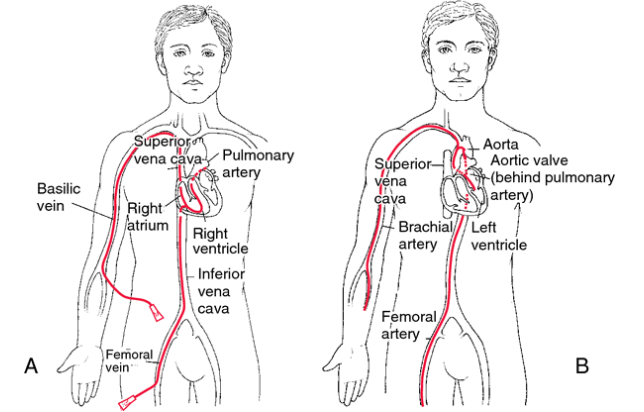Cardiac catheterization is a procedure that provides information to your physician on how well your heart is working. It evaluates the heart muscle, valves and coronary arteries; and allows for procedures to open blocked arteries. A thin, flexible tube called a catheter is inserted into a large blood vessel in your leg (groin) or arm that leads to your heart. The catheter allows your doctor to take pictures and perform tests inside your heart. During your cardiac catheterization, procedures may be completed such as angiography, angioplasty and stenting. Angiography involves using contrast dye and taking xray pictures of blood vessels that can show the location and severity of blockages in the vessels. In angioplasty, the catheter is used to place a special balloon in the artery. The balloon is inflated and deflated to compress plaque and open the artery. A stent may be permanently placed in the narrow part of the artery to help keep the path of blood flow open.
Risks and complications of cardiac catheterization are infrequent, but may include:
- Bleeding, infection or blood clots
- Allergic reaction to the contrast dye
- Abnormal heartbeat (arrhythmia)
- Damage to blood vessels or tissues
- Kidney damage or failure
- The need for emergency heartsurgery
- Heart attack, stroke or death

Preparing for the Procedure
- Tell your doctor what medications you are taking – including any over the counter medications, herbal remedies or supplements.
- You will be given instructions about what medications to take or stop before the procedure.
- Please have a light breakfast the morning of your procedure (no caffeine)
- Tell your doctor if you are allergic to anything including iodine, shellfish, any medications, latex or x-raydye
- Tell your physician if you are pregnant or you think you could be pregnant
- Arrange for someone to drive you home after the procedure
During the Cardiac Catheterization
- An intravenous (IV) will be inserted into your arm. You will be given medication to help you relax, but you will be awake and able to follow instructions during the procedure
- The area where the catheter is inserted will be cleaned and shaved
- A local anesthetic is given to numb the incision site
- The doctor will guide the catheter as it is threaded through the blood vessels and into the heart. You may feel some pressure, but you shouldn’t feel any pain. Depending on the procedures that follow, various instruments may be used and/or the catheter may be removed and replaced several times to be able to reach different parts of the heart or vessels.
After the Procedure
Pressure will be applied to the incision site to stop the bleeding. You will need to keep your arm or leg straight and you will not be able to get out of bed during the observation period. You will be monitored during this time by nursing staff. You will receive discharge instructions from the nursing staff prior to going home
At Home:
Be sure to follow the discharge instructions to care for yourself provided by the hospital staff

